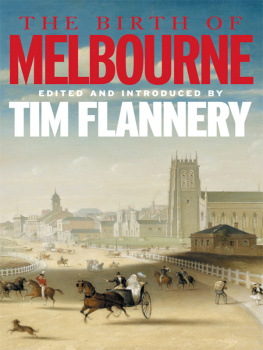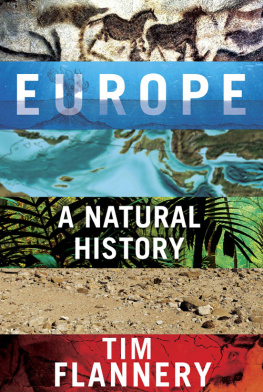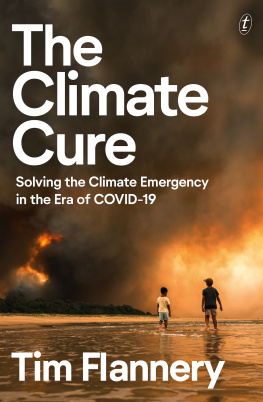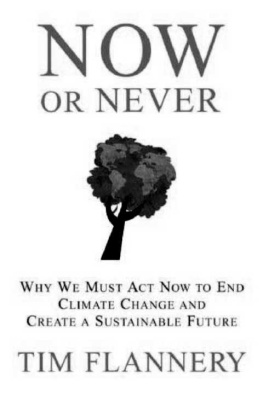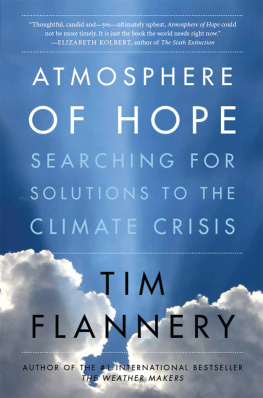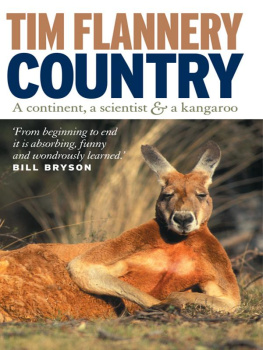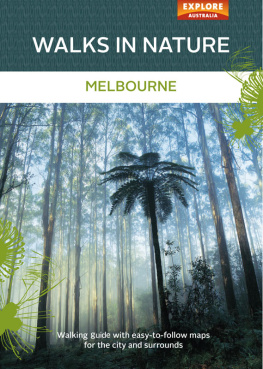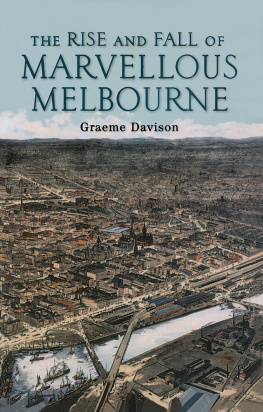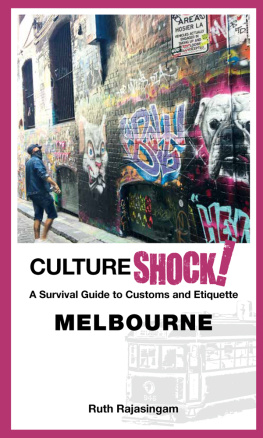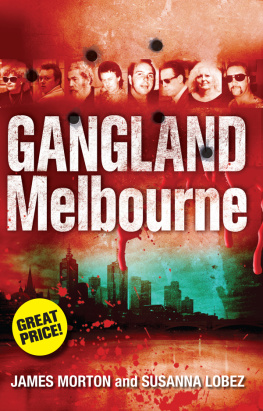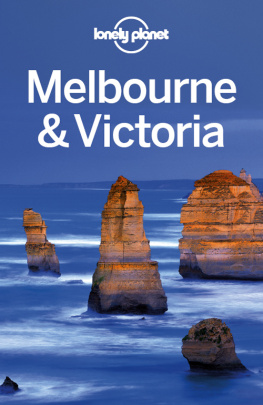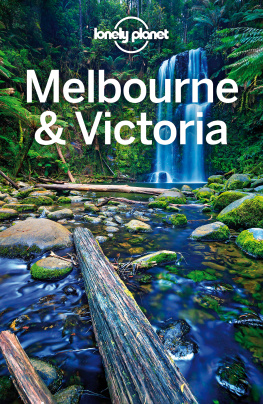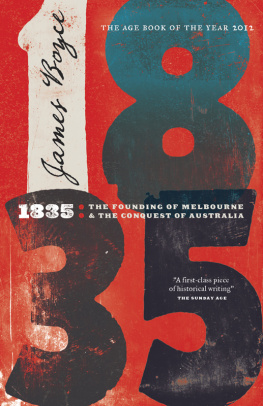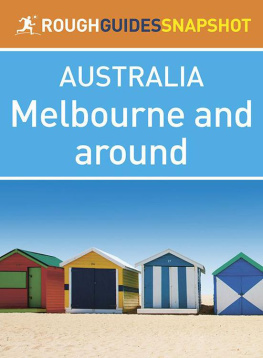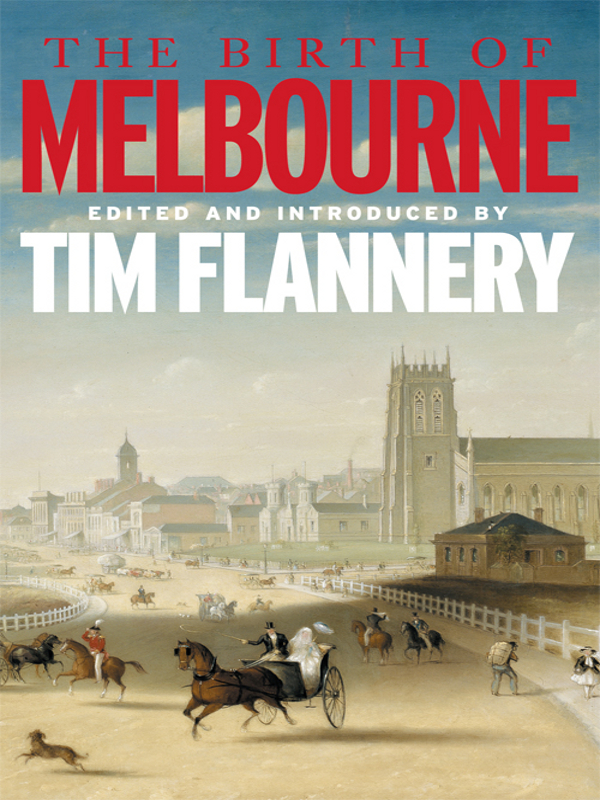
THE BIRTH OF MELBOURNE
Tim Flannery is a naturalist, explorer and writer. His many books include the bestsellers The Future Eaters, Throwim Way Leg and The Weather Makers, and he has made contributions of international significance to the fields of palaeontology, mammalogy and conservation. In 2007 he was named Australian of the Year.
OTHER BOOKS BY THE AUTHOR
Mammals of New Guinea
Tree Kangaroos: A Curious Natural History
with R. Martin, P. Schouten and A. Szalay
The Future Eaters: An Ecological History of the Australasian
Lands and People
Possums of the World: A Monograph
of the Phalangeroidea with P. Schouten
Watkin Tench, 1788 (ed.)
John Nicol, Life and Adventures 17761801 (ed.)
Throwim Way Leg
The Explorers (ed.)
Terra Australis: Matthew Flinders Great Adventures in the
Circumnavigation of Australia (ed.)
The Eternal Frontier: An Ecological History of North America and Its
Peoples
A Gap in Nature: Discovering the Worlds Extinct Animals
with P. Schouten
John Morgan, The Life and Adventures of William Buckley (ed.)
Joshua Slocum, Sailing Alone around the World (ed.)
Astonishing Animals with P. Schouten
Country
The Weather Makers: The History & Future Impact of Climate Change
We Are the Weather Makers: The Story of Global Warming
THE BIRTH OF
MELBOURNE
EDITED AND INTRODUCED BY
TIM FLANNERY

TEXT PUBLISHING
MELBOURNE AUSTRALIA
The Text Publishing Company
Swann House
22 William St
Melbourne Victoria 3000
Australia
www.textpublishing.com.au
Copyright Tim Flannery 2002
All rights reserved. Without limiting the rights under copyright above, no part of this publication shall be reproduced, stored in or introduced into a retrieval system, or transmitted in any form or by any means (electronic, mechanical, photocopying, recording or otherwise), without the prior permission of both the copyright owner and the publisher of this book.
First published 2002
This edition published 2004, reprinted 2007
Printed and bound by Griffin Press
Designed by Chong Wengho
Typeset in Stempel Garamond by Midland Typesetters
National Library of Australia
Cataloguing-in-Publication data:
The Birth of Melbourne.
Bibliography.
ISBN 1 877008 89 3.
ISBN-13 978 1 877008 89 4.
1. Melbourne (Vic.) History 17881900. I. Flannery,
Timothy Fridtjof, 1956.
994.4102
Cover painting by Henry Burn, Swanston Street from the Bridge, 1861, oil on canvas, 71.8 x 92.2cm, gift of Mr John H. Connell, 1914, National Gallery of Victoria, Melbourne.
Every effort has been made to trace the original source material contained in this book. Where the attempt has been unsuccessful, the publishers would be pleased to rectify any omission.
Contents
by Tim Flannery
TIM FLANNERY
A ll cities spring from twin fountainheadsthe nature in which they are grounded and the human enterprise that builds them. Nature works slowly and at times can be set on her beam-ends by ecological disruptions, yet ultimately she determines the fate of every living thing. Melbournes history has been one of prodigious human activity and unimaginable ecological catastrophe. Just 170 years ago the city did not exist. In its place was Birrarang, a bountiful land beside a bay, through which ran the sparkling river Barrern. This was a place of astonishing beauty and abundance, with roots deep in Gondwana.
A remarkable insight into Birrarangs origins came in early 1980 when a builder on Melbournes underground rail loop noticed a strange shape in a rock fragment that had broken off the tunnel wall. At first glance it looked like a Wild West sheriffs badgea suitable emblem of Melbournes frontier phasebut when held to the light it proved to be the immaculately preserved impression of a starfish. Although the creature lived 400 million years ago, even its smallest details remained discernible.
That lonely, pioneering starfish was probably entombed by a mudslide as it wended its way across the sea floor. Could we have taken a birds-eye view of Melbourne back then we would have seen nothing but water. Below that horizon-spanning expanse of salt water lay a vast gash in the ocean bottom called the Melbourne Trougha sort of prototypical Marianas Trench. It occupied much of what is now central Victoria, and the muds and silts that filled it were destined to form the rolling hills of Melbourne, as well as much of the rock underlying the city itself.
A place near the outer suburb of Lilydale tells us how this ancient mud was transformed into solid rock. The Europeans called it Cave Hill and dug a quarry there. The Aborigines, however, knew it as Bukker Tillible, and believed that a falling star had created a bottomless pit on the site. The cave the legend refers to had been carved from a mass of limestone, rich in shells and other ancient marine life. How this great slab of limestone, kilometres in extent, ended up on the floor of a deep ocean trench was a mystery until geologists discovered evidence nearby of volcanoes. This primitive coral reef must have grown on the summit of such a peak, near the sunlit surface of the ocean, until a tremendous paroxysm of the earths crust some 380 million years ago detached the limey mass from its pinnacle, sending it hurtling into the abyss.
This was only one of countless geological movements that over tens of millions of years would bury errant starfish and close the Melbourne Trougheventually folding and heating the sediment, then thrusting the mass of new-formed rock skyward. Tectonic forces also squeezed great bodies of magma into the rock, which slowly cooled and solidified to form the granite that now outcrops around Melbourne. In time these processes would transform the entire region from sea to land, creating the continental crust that would come to be known as Victoria.
These continent-creating processes also emplaced a thin trace of metal in the sediment, which was concentrated in northsouth running beltstwo to the east of Melbourne and one to its west. After lying dormant for over 350 million years the immense motivating power of this golden trace was released like a genie from a bottle. Although only 2500 tonnes of gold have been mined in Victoria, this was enough to create marvellous Melbourne in the geological blink of an eye.
From the age of fishes some 350 million years ago, through the age of dinosaurs and into our own age of mammals, we know little of what passed in Melbourne-to-be, for few rocks are preserved to inform us. But by around 40 million years ago a vital geological event took place that enables us to pick up the story once more. Volcanoes began erupting around Victoria, particularly in the west, and the rocks their lava produced including Melbournes famous bluestonecan be dated by geologists. In time the basalt would break down to form the largest area of rich soils in Australia. This, combined with the regions reliable winter rainfall, would make it one of the continents most productive regions, and it was this that drew Melbournes first settlers.
Lava flows occurred only to the west of the Yarra in the Melbourne area, so the city sits astride two very different natural realmsrich volcanic plains, and infertile sand-sheets and swamps to the east. The place is like a two-faced god, offering either fortune or heartbreak. The first Europeans to settle the area turned right when they passed through the Heads into Port Phillip Bay. This fateful choice meant that they encountered Melbournes poorer if more picturesque side, and were defeated by the sterility of the land. In 1835, thirty-three years later, Batman turned left on entering the bay and the natural riches he unlocked astonished the world.
Next page
